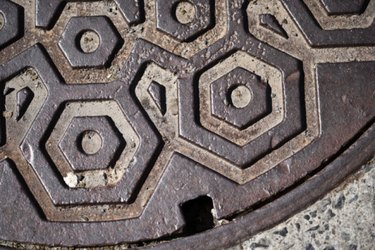Things You'll Need
Shovel
Old towels
Hacksaw
File
Tape measure
Replacement PVC pipe
PVC glue
PVC connectors
Sand or gravel
Plumbing inspector

A broken septic or sewer line can cause a slushy and smelly mess in your yard. Extreme heat, cold and age can eventually lead to cracks in your home sewer lines. Even the simplest sewer line repairs can make for back-breaking work, so this is something you may want to consider before taking on the job yourself. In fact some counties and municipalities require that all sewer line replacement and repairs be performed by a licensed professional. Check first with the proper authorities before tackling sewer line repairs on your own.
Step 1
Locate the area where the septic line is broken. If the line has recently been broken, the ground may be soggy around the break. Find the sewer trap right outside your home and then find the main sewer outflow near the edge of your property. Probe the ground with a shovel and dig a little until you expose the sewer line.
Video of the Day
Step 2
Have your water and sewer utility company shut off the water to your house while the repairs are made.
Step 3
Dig out the ground around the damaged section of sewer line completely. Be careful, though, while digging so you do not cause additional damage to your septic line.
Step 4
Use an old rag to wipe the damaged section of the line completely clean.
Step 5
Cut the damaged section of septic line out with a hacksaw. Use a file to smooth the edges down after you have cut them. Once you have removed the damaged section, measure it with a tape measure and then cut a fresh section of PVC pipe to the same length.
Step 6
Apply PVC glue to one end of the existing line you have sawed off. Attach a PVC connector to that end of the pipe. Repeat this procedure to attach a connector to the other end of the sawed off line.
Step 7
Apply PVC glue to each end of the replacement pipe you have cut to length. Quickly place one end of the pipe into one PVC connector and the other end into the other PVC connector. Allow 30 minutes for the connection to set.
Step 8
Have the water turned back on to your house and have a plumbing inspector approve your repairs.
Step 9
Add a small amount of gravel or sand beneath the repaired pipe. Use a shovel to fill the dirt back in that you dug out to access the septic line.
Warning
If your sewer lines are old and made of ceramic material, or if the damaged section of the line runs under a cement slab like your driveway or a sidewalk, you will need to contact a professional plumber to handle this job.
Video of the Day